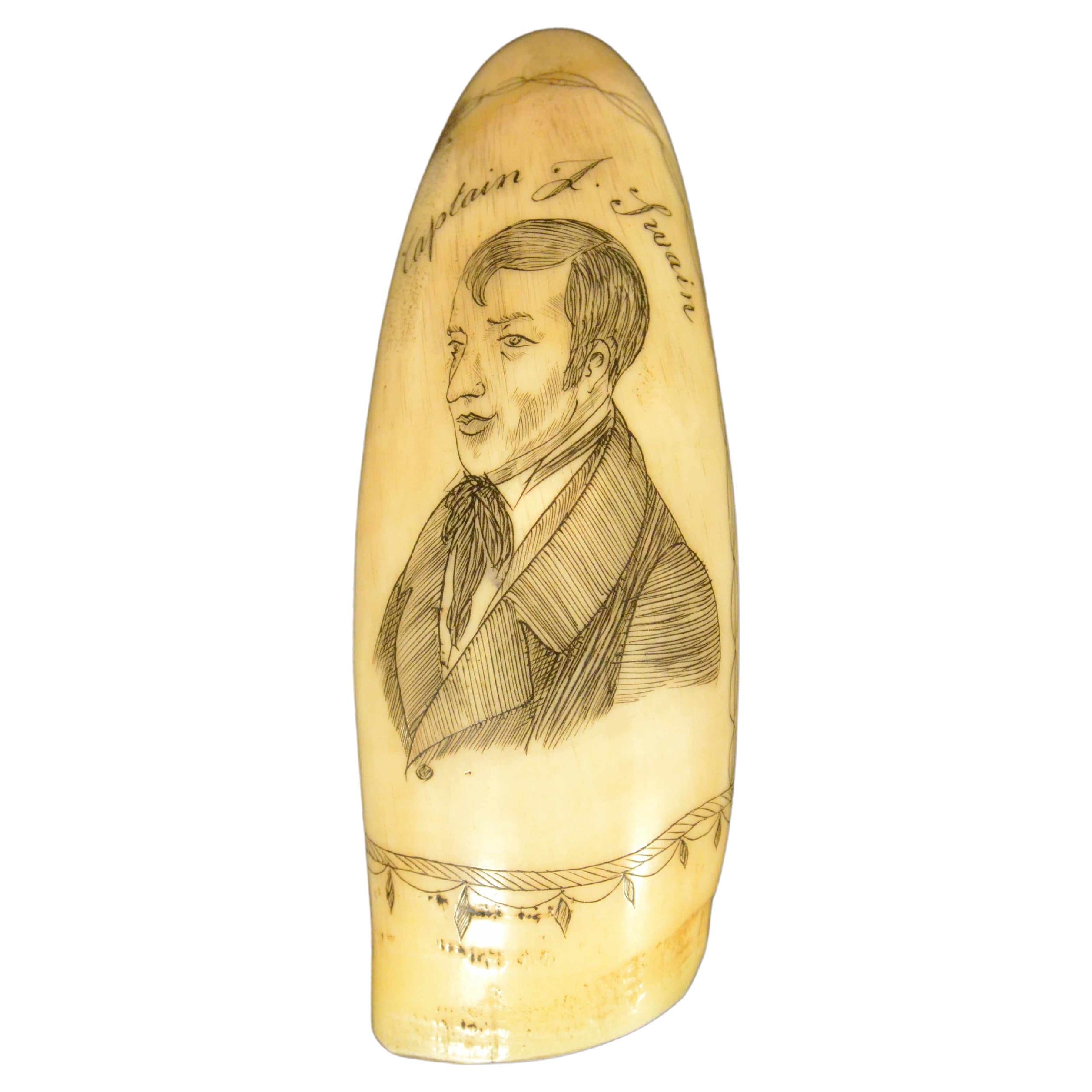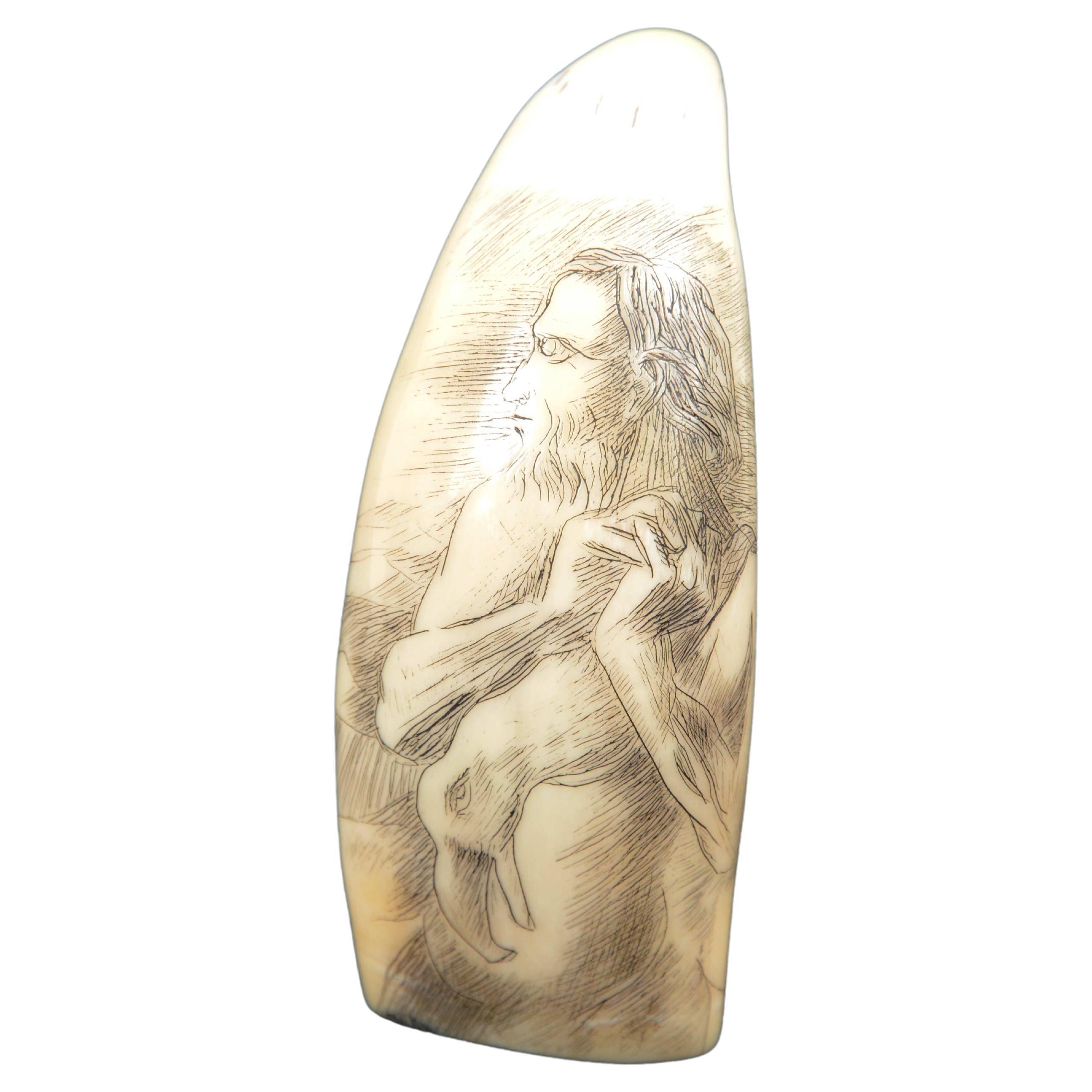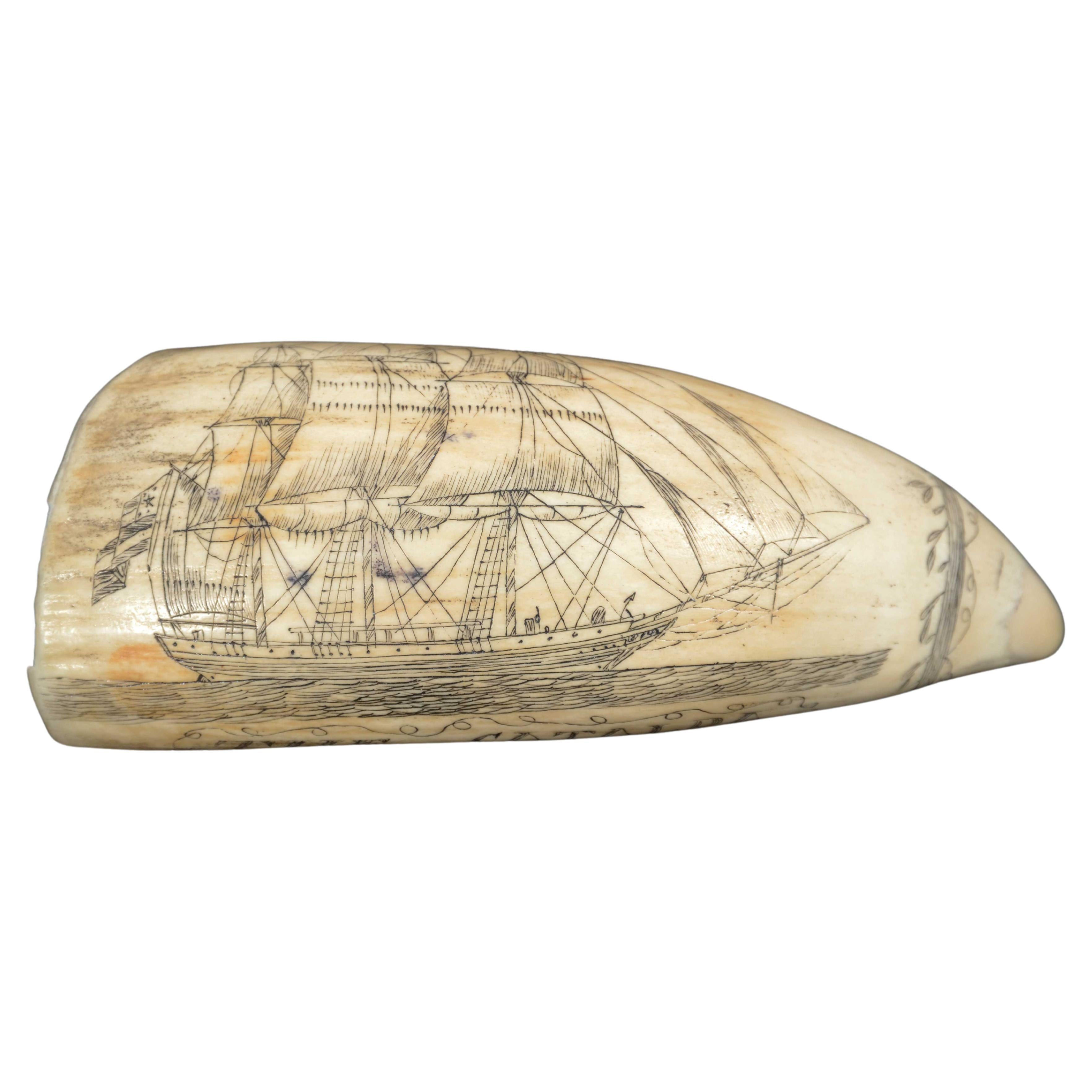Items Similar to Scrimshaw of an engraved whale tooth dated 1861 depicting SHIP NOLAN
Want more images or videos?
Request additional images or videos from the seller
1 of 12
Scrimshaw of an engraved whale tooth dated 1861 depicting SHIP NOLAN
About the Item
Scrimshaw of an engraved whale tooth dated 1861, depicting on one side large sailboat with sails unfurled of excellent workmanship and underneath the name SHIP NOLAN.
On the back, a large Greek goblet vase is engraved, with double handles finely decorated and filled with flowers and ears of corn, on the sides flakes as decorative elements and the date 1861.
Bon état. Measures 8x4x2.5- inches 3.2x1.6x1.
The word scrimshaw refers to an art form (and the various products of this art) that developed aboard American whaling ships between 1745 and 1759 as a means of recreation to occupy time during the long hours aboard; this art form consisted of a process of carving and carving whale bones and teeth, with which a wide range of both everyday and ornamental objects were made, which were usually made as souvenirs for members of one's family. Nella scelta dei materiali il primo era sicuramente il dente d'avorio del capodoglio. Solo la punta del dente era liscia ed era necessario preparare il resto della superficie ruvida lucidandola. Il dente era ben immerso in acqua salata o calda, spesso con l'aggiunta di potassio. Quindi veniva utilizzata una lima per strofinare e arrotondare la superficie, e infine una carta vetrata fine per completare il processo. L'ultima fase della lucidatura veniva eseguita con pomice o cenere e poi il dente veniva strofinato ancora con il palmo della mano. Each step had to be performed very slowly so as not to affect the smooth surface of the tooth. In terms of subjects for scrimshandering, the most common were a drawing of a ship or scenes of cetacean capture, made with a needle or knife, or an appropriate blade: for example, thanks to Herman Melville we know that some whalers had boxes of dentist's tools specially designed for scrimshandering. The origin of scrimshandering, as the whalers called it, i.e., the art of making scrimshaw, is a mystery: theories range from locating its origin in Eskimo culture or with Native Americans to emphasizing the influence of South Sea islanders. La spiegazione di Edouard A. Stackpole (1903 -1993), giornalista americano, scrittore e storico di caccia alle balene, è forse la più plausibile: lo scrimshaw sarebbe stato semplicemente lo sviluppo marittimo dell'antica arte di intagliare l'avorio, così come era stata praticata per secoli, e in quanto forma d'arte popolare non sarebbe stato altro che un adattamento da parte dei balenieri americani di un antico mestiere.
- Dimensions:Height: 3.2 in (8.13 cm)Diameter: 1.6 in (4.07 cm)
- Materials and Techniques:Teeth
- Period:
- Date of Manufacture:1861
- Condition:Wear consistent with age and use.
- Seller Location:Milan, IT
- Reference Number:1stDibs: LU1020237600562
About the Seller
4.9
Platinum Seller
These expertly vetted sellers are 1stDibs' most experienced sellers and are rated highest by our customers.
Established in 1999
1stDibs seller since 2014
370 sales on 1stDibs
Typical response time: <1 hour
- ShippingRetrieving quote...Ships From: Milan, Italy
- Return PolicyA return for this item may be initiated within 14 days of delivery.
More From This SellerView All
- Scrimshaw of a vertically engraved whale tooth Ship Huron dated 1839 cm 9Located in Milan, ITScrimshaw of a vertically engraved whale tooth, exquisite workmanship dated 1839, height cm 9, depicting whaler near a rock and partially submerged whale, under the name of the ship...Category
Antique 1830s Nautical Objects
MaterialsTeeth
- Scrimshaw of engraved whale tooth depicting the Captain F. Swain 1850Located in Milan, ITScrimshaw of an engraved whale tooth, depicting on one side the half-bust of the smartly dressed and handsome Captain F. Swain. On the Back the inscription Master The WHALER SWAN f...Category
Antique Mid-19th Century Nautical Objects
MaterialsTeeth
- 7990 Scrimshaw of vertically engraved whale tooth dated around 1850Located in Milan, ITScrimshaw of a vertically engraved whale tooth datable to around the mid-19th century depicting an old sailor with a beard and long hair holding leaning over one shoulder a cormoran...Category
Antique 1850s Nautical Objects
MaterialsTeeth
- Scrimshaw of vertically engraved whale tooth valuable workmanship dated 1882Located in Milan, ITScrimshaw of a vertically engraved whale tooth, of fine workmanship dated 1882, length 12 cm - inches 4.8. The tooth depicts: 6 whalers in rowboat trying to harpoon a whale and whal...Category
Antique 1880s Nautical Objects
MaterialsBone
- Scrimshaw of excellently made engraved whale's tooth dated around 1850Located in Milan, ITScrimshaw of an engraved and beautifully crafted whale tooth dated around the mid-19th century depicting vessel with full sails under sail, on the back a lady in a long dress with in...Category
Antique Mid-19th Century Nautical Objects
MaterialsTeeth
- Scrimshaw of engraved whale tooth depicting naked woman with very 1850s faceLocated in Milan, ITScrimshaw of an engraved whale tooth, depicting naked woman with a very end, with long hair and turgid breasts flying the American flag, on the back large vessel with sails unfu...Category
Antique Mid-19th Century Nautical Objects
MaterialsTeeth
You May Also Like
- New Bedford Whale Ship Model Of "Cortez"Located in Norwell, MANew Bedford whale ship model "Cortez". Full wood model, fully rigged. Made by Captain Hall. Provenance: Original owner purchased ship model from the New Yor...Category
Vintage 1930s North American Models and Miniatures
MaterialsWood
- 19th Century Irish Folk Art Whale ToothLocated in Coeur d'Alene, IDIrish Folk Art. This sperm whale tooth was etched during the 19th century, in Ireland. There'sa a drinking sailor on one side, and a barmaid on the other -...Category
Antique Late 19th Century Northern Irish Nautical Objects
MaterialsOther
- Abraham Lincoln Signed Military Commission, Dated September 9 1861Located in Colorado Springs, COThis war-dated Army commission for Second Lieutenant Joseph Audenried is signed by Abraham Lincoln. The signature is accompanied by a reproduction photograph of Lincoln in 1863. The original commission was signed by Lincoln on September 9, 1861 and assigns Audenned to the famed 1st Regiment of the U.S. Cavalry. Only five months after the start of the American Civil War, Lincoln signed this back-dated commission. Although it was approved September 9th, the promotion states that Audenried would have been Second Lieutenant since June 24, 1861. Exact commission dates were hotly argued among soldiers at the time. Not only did it determine how much an individual should be paid, but it also provided a clear hierarchy valuing seniority among those of the same rank. Immediately preceding this document, the Union had suffered several major losses including the First Battle of Bull Run and the Battle of Wilson’s Creek. Claiming only minor battle victories, the Union was beginning to have doubts about its military leadership and the brevity of the war. The same year Lincoln wrote to a Union General, “He who does something at the head of one Regiment, will eclipse him who does nothing at the head of a hundred.” The First Cavalry was an instrumental part of the Union’s advancements into Confederate territory. Organized by an act of Congress in 1861, most of the cavalry fought in the Peninsula Campaign in Virginia but also played a major role on the Rapidan Line, the Raid of Richmond, and Sheridan’s advancement through the Shenandoah Valley. The commission document signed by President Lincoln also bears the signature of Simon Cameron, then Secretary of War. A re-print photograph of Lincoln accompanies the document. Photographed by Alexander Gardner, this portrait is often referred to as the “Gettysburg Portrait,” seeing as only two weeks later, Lincoln gave his famous Gettysburg Address. Condition: This original signed document...Category
Antique Mid-19th Century American Historical Memorabilia
MaterialsPaper
- Large 19th Century Presentation Half Hull Model of a Whale ShipLocated in Nantucket, MA19th Century Presentation Half Hull Model of a Whale Ship, circa 1850, a large plank on frame model of a bluff-bowed and wide abeam whale ship. The model wa...Category
Antique Mid-19th Century American Folk Art Nautical Objects
MaterialsPine
- Old Print of Ascension Island with Ships, a Whale and Flying Fish, 1601Located in Langweer, NLAntique print, titled: 'Vera effigies et delineato Insulae Ascenstio …' - Bird's eye view of Ascension Island. Five large sailing ships in the background and flying fish and waterfow...Category
Antique Early 1600s Prints
MaterialsPaper
- Anatomical Model Depicting an Intestine, Italy 1890Located in Milan, ITAnatomic model for class, depicting a man’s intestine, made out of painted papier maché. Italy 1890 ca.Category
Antique Late 19th Century Italian Scientific Instruments
MaterialsMetal
Recently Viewed
View AllMore Ways To Browse
Nautical Cast Iron
Iron Pulley
Vintage Nautical Life Rings
Retro Diving Helmet
Ship Compass Hand Held
Antique Divers Helmet
Antique Inclinometer
Antique Microscope Wooden Box
Antique Nikon
Antique Wood Screw Clamps
Brass Seashell Ashtray
Deep Sea Divers Helmet
Deep Sea Diving Helmet
Nautical Flag Letter M
Nautical Walking Stick
Needle Trade Sign
Rb Spencer
C W Dixey





